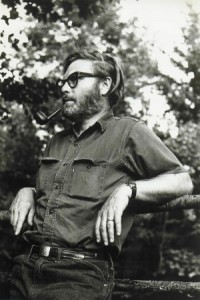Notables: Hayden Carruth
By Lindsey Pizzica Rotolo
As we begin another summer season in Norfolk, our sleepy town’s pulse begins to quicken. The number of cars and pedestrians multiplies seemingly overnight, forcing us back into the habit of actually looking both ways before turning onto any of our roads—a sure sign that “the summer people” are here.
Summer residents have been a part of Norfolk’s history since the late 1800’s. One notable short-term denizen was the poet Hayden Carruth. As is the story behind most seasonal residents’ discovery of Norfolk, Carruth was introduced to town by a friend (and employer), James Laughlin, or Jas, as Carruth called him.
The decade preceding Carruth’s introduction to Norfolk was not easy. He began the 1950’s in Chicago editing Poetry Magazine, but things fell apart quickly as his excessive drinking and phobias made him unbearable to work and live with. His first wife, Sara Hudson, left him in 1951 and his second wife, Eleanor Ray, left him in 1953.
At a time when nobody in the publishing world would give him a job, Laughlin gave him editorial work at Intercultural Publications in New York. In Carruth’s memoir of Laughlin, “Beside the Shadblow Tree,” he writes, “Why did Jas hire me to come from Chicago and join him at Intercultural when so many other qualified people were already on the scene? I never knew, I was too shy to ask, and I guess Jas in his different way was too shy to say.”
Carruth entered the White Plains branch of New York Hospital in 1953, where he received hydrotherapy and electroshock therapy for 15 months. Laughlin paid for his treatment, and kept in touch the entire time, often asking for editorial help on various projects. For five years upon his release, Carruth lived in the attic of his parents’ house in Pleasantville, N.Y. where he wrote his first book of poetry, “The Crow and the Heart.” He writes of that time, “I had agoraphobia, claustrophobia, acrophobia, and every other phobia known to man.” But eventually, his mental condition improved and he was able to leave the house.
In the spring of 1961, Laughlin asked Carruth to come to Norfolk and organize his collection of literary magazines so they could be donated to a university library. Carruth accepted. The job took three days. Carruth returned to his parent’s home for a brief time, and then Laughlin offered him another, more daunting job of organizing all the New Directions files in return for free rent at the Robin Hill cottage. Carruth was quick to oblige.
The summer of 1961 was Carruth’s 39th (he turned 40 that August). He was still battling depression and anxiety, which plagued him his entire life, but he took solace in the woods of Tobey Pond, 40 miles from his hometown of Woodbury, Conn. He recalled the beginning of his stay in Norfolk that summer, “On the first morning I was up with the sun, dressed and out, nervy, heading down the road to Tobey Pond for a look at my new surroundings. But before I’d gone a quarter-mile I was attacked by more blackflies and deerflies than I’d ever seen before…driving me—running, stumbling, flailing the air around my head—back to the cottage. It was a somewhat discouraging initiation.”
Things improved from there. Carruth must have grown accustomed to the flies because he wrote of walking every day that summer—“going up Canaan Mountain to the reservoir and Seldom Seen Pond and the Yale tree plantation.” He fell in love with Rose Marie Dorn, a governess from East Germany (construction of the Berlin wall began in August 1961), who was spending the summer at the camp at Robin Hill, and they married three months later.
Carruth wrote an entire book of poetry in that time, entitled, “The Norfolk Poems of Hayden Carruth.” One of those poems, “Inevitable Didactic,” captures how at peace he was in Norfolk that summer: “The cottage is small but strongly built/Slate, brick and chestnut all the best/And I curl inside like a child in a quilt/Cozy and free in my dreams and warm/As my poems curl, I hope, in their form/Snugly protected but never oppressed.”
Dorn and Carruth eventually moved up to Vermont, 25 miles from the Canadian border, but it was yet another failed marriage for Carruth. His one true love finally came into his life in the form of a poet, Joe-Anne McLaughlin, 30-years his junior. One of many passages he wrote about her reads, “Oh sweetheart, Mrs./ Manitou of the Stockbridge Valley/my Red Head, my Absecon Lakshmi of the Marshlights/my beautiful beautiful Baby Doll/let the dying be long.” They lived in Munnsville, New York, halfway between Syracuse and Utica.
The poet’s friendship with Laughlin continued until Laughlin’s death in November of 1997. Carruth visited Norfolk regularly throughout his life, with his last visit taking place in the summer of 1998 for Laughlin’s memorial service. Carruth died ten years later at the age of 87. He published over 30 books in his lifetime, poetry as well as criticism. “Scrambled Eggs & Whiskey: Poems 1991-1995” received the National Book Award for Poetry, and “Collected Shorter Poems, 1946-1991” received the National Book Critics’ Circle Award. He taught at Bucknell University and at Syracuse University.

